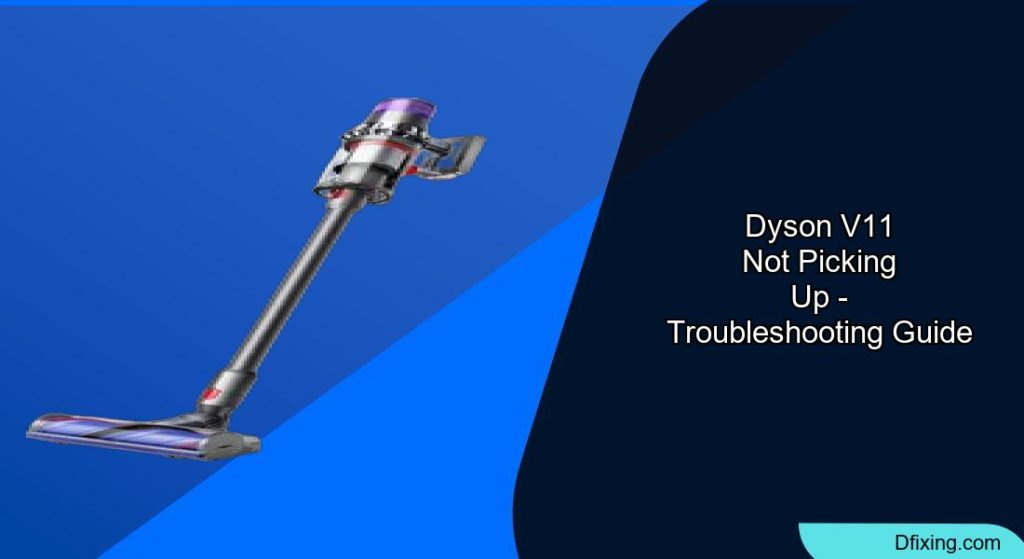Common Causes of Suction Loss in Dyson V11
When your Dyson V11 stops picking up debris effectively, it’s typically due to a loss of suction power. Several components can be responsible for this frustrating issue. The most frequent culprits include clogged filters, blocked hoses, and full dust bins. More complex problems might involve motor malfunctions, battery issues, or electrical component failures.
Affiliate disclosure: As an Amazon associate, We'll earn a commission for every successful order through our affiliate links in the article. However, you won’t be charged anything for this.
Before assuming your vacuum needs professional repair or replacement, it’s worth working through a systematic troubleshooting process. Many Dyson V11 suction problems can be resolved with simple maintenance procedures that don’t require technical expertise. The following sections will guide you through each potential issue, from basic checks to more advanced solutions.
Essential Dyson V11 Troubleshooting Steps
Checking and Cleaning the Filter System
The filter is often the primary cause of reduced suction in Dyson V11 vacuums. When filters become clogged with fine dust and debris, they restrict airflow through the machine:
- Remove the filter by gently pulling it out of its housing
- Examine it for visible dirt accumulation or blockages
- For washable filters, clean with lukewarm water (no detergents)
- Allow the filter to dry completely for at least 24 hours before reinstalling
Important warning: Never reinstall a damp filter. Moisture that reaches the motor can cause permanent internal damage. If your filter has been exposed to water and you need to use the vacuum immediately, you’ll need to install a replacement filter instead of waiting for the original to dry.
If you’ve washed your filter and need to vacuum before it’s completely dry, or if your existing filter is damaged, a replacement is essential to avoid damaging your Dyson.

Official genuine replacement for optimal performance

Cost-effective with premium HEPA filtration

Includes cleaning brush for maintenance

Upgraded material for enhanced durability
Clearing Blockages in the Hose and Wand
A blocked hose significantly impairs your Dyson V11’s performance. Follow these steps to inspect and clear any obstructions:
- Disconnect the wand from both the cleaning head and the main unit
- Hold it up to a light source to check for visible blockages
- Use a long, thin object (like a broom handle) to carefully push out any debris
- Check both ends of the wand for buildup that might be restricting airflow
- Reconnect the components once clear
Emptying and Cleaning the Dust Bin
A full or dirty dust bin reduces suction power and overall performance:
- Empty the bin after each use, especially when dealing with fine dust or pet hair
- Press the red release button to detach the bin from the main unit
- Hold it over a trash can and press the red emptying mechanism
- For thorough cleaning, rinse the bin with cold water (no detergents)
- Ensure it’s completely dry before reattaching to avoid moisture damage
Examining the Brush Bar for Obstructions
Hair and fiber tangles around the brush bar can prevent proper contact with surfaces:
- Turn off the vacuum and disconnect the cleaning head
- Locate the end cap of the brush bar (usually secured with a coin-slot fastener)
- Rotate to unlock and remove the brush bar
- Cut away any tangled hair or fibers with scissors
- Clean the brush housing of any debris before reinstalling
- Ensure the end cap is securely fastened after reassembly
Advanced Troubleshooting for Persistent Issues
Addressing Motor and Fan Assembly Problems
If your Dyson V11 is making unusual noises or has severely reduced suction despite cleaning all accessible parts, the motor or fan assembly might be affected:
- Listen for grinding, whining, or irregular motor sounds
- Check if the vacuum produces any suction at all
- Inspect for burning smells that might indicate motor overheating
For motor issues, professional repair is typically recommended as disassembly requires specialized tools and expertise. However, if you’re comfortable with electronics:
- Remove the battery and ensure the vacuum is completely powered down
- Carefully disassemble the upper housing following manufacturer guidelines
- Inspect the fan blades for damage or debris
- Clean accessible components with compressed air
- Reassemble following the reverse procedure
Resolving Battery Health Issues
A failing battery affects overall performance and suction power:
- Check the battery indicator on your Dyson V11’s display
- Ensure the battery is fully charged before testing
- If the vacuum loses power quickly, try calibrating the battery:
- Run the vacuum until it completely shuts off
- Charge it fully without interruption
- Test to see if runtime has improved
For removable battery models, try this reset procedure:
- Power off and unplug the vacuum
- Remove the battery by pressing the release button or unscrewing it
- Press and hold the power button for 15-20 seconds to discharge residual power
- Reinstall the battery and charge fully
- Test operation to confirm functionality
If problems persist, a battery replacement may be necessary.
If your Dyson V11 isn’t holding a charge or is dying quickly, a new battery can restore its original run time.
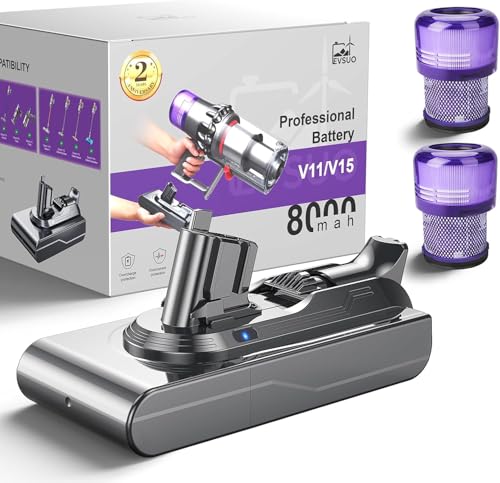
Premium high-capacity battery with 30% faster charging and 80+ minutes runtime

High-capacity battery with intelligent protection and 12-month warranty
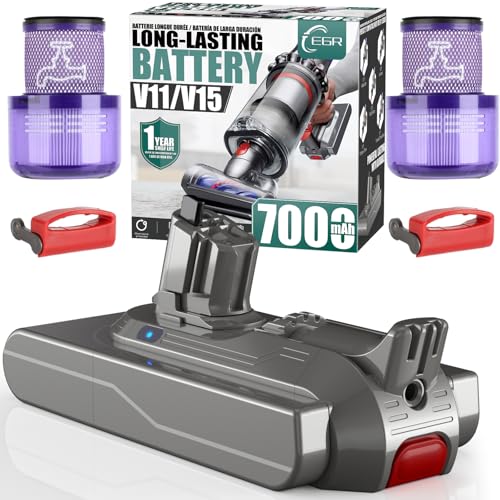
Durable battery with non-slip strip for wall storage and safety protection
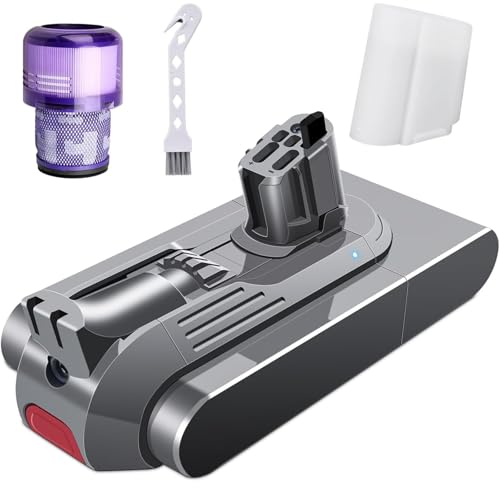
Balanced performance with military-grade safety and 24-hour support
Fixing Trigger and Display Malfunctions
When your Dyson V11 shows no display and doesn’t respond when the trigger is pressed:
- Check that the battery is properly seated and charged
- Inspect the trigger mechanism for visible damage
- Try the battery reset procedure described above
- If available, test with a different battery to determine if the issue is battery-related
- If the problem persists, the trigger assembly may need replacement
Solving Specific Dyson V11 Problems
Clearing the Pre-Filter Housing Clog
A unique issue with Dyson V11 models involves clogs in the pre-filter housing near the canister’s exhaust hole:
- Open the canister by pressing the release tab
- Locate the exhaust hole and the narrow, curved passage (approximately 8 inches deep)
- Use a wooden chopstick or similar non-sharp tool to carefully probe and dislodge debris
- Continue until all obstructions are removed
- Reassemble and test suction power
This often resolves high-pitched wheezing noises and restores normal function, especially for pet owners or those with high-pile carpets.
Separating a Stuck Cleaning Head from the Wand
If you’re struggling to detach the cleaning head from the wand:
- Ensure you’re pressing the red release button completely
- Position the vacuum at a 90-degree angle to the floor to reduce stress on the connection
- Apply a small amount of silicone spray to the connection point (avoiding electrical contacts)
- Gently wiggle while pressing the release button
- For persistent issues, some users have found success by carefully filing down the edge of the red button that catches in the housing
Resolving Boost Mode Failures
Some users report that their Dyson V11 loses suction only in “boost” mode, despite working normally in medium or economy settings:
- Perform all standard cleaning procedures for filters, bins, and pathways
- Check for partial blockages that might only affect high-airflow situations
- Inspect the battery’s charge level, as boost mode requires maximum power
- If the issue persists only in boost mode after thorough cleaning, contact Dyson support as this may indicate a specific component issue
Maintenance Tips for Optimal Performance
Regular Cleaning Schedule
Establish a routine maintenance schedule to prevent suction loss:
- Empty the dust bin after each use
- Rinse the bin monthly with cold water
- Wash the filter every 3-4 weeks (if washable)
- Check for blockages in the wand and hose monthly
- Clean the brush bar every 1-2 months, depending on usage
Proper Storage Practices
How you store your Dyson V11 affects its longevity:
- Use the wall-mounting dock to keep the vacuum upright
- Store in a cool, dry location away from direct sunlight
- Keep the battery at least partially charged during extended storage
- Remove the battery if storing for more than a month without use
- Ensure all components are completely dry before storage
If your wall mount is damaged or missing, replacing it will ensure proper storage and charging of your Dyson V11.

Official replacement with dual storage slots and secure wall mounting

Matches original design with premium cable organization

Flexible installation with dual accessory storage
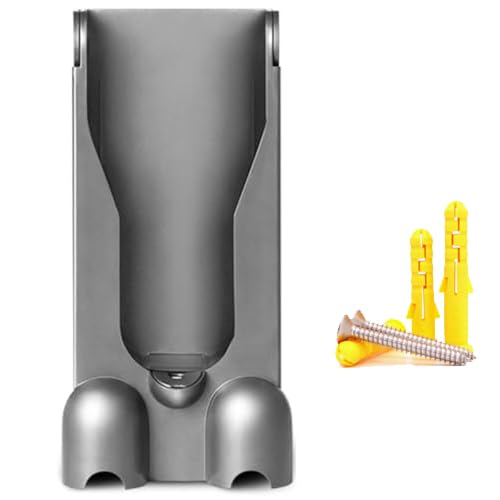
Affordable replacement with essential cable management
Extending Battery Life
Maximize your battery’s lifespan with these practices:
- Avoid completely depleting the battery before recharging
- Use the appropriate power mode for each cleaning task (economy mode for routine cleaning)
- Store at room temperature, avoiding extreme heat or cold
- Perform a full discharge/recharge cycle once every 3 months
- Replace the battery every 2-3 years with heavy use
Frequently Asked Questions (FAQ)
Why does my Dyson V11 keep shutting off when I pull the trigger?
This is often caused by a blockage or overheating protection. The vacuum may flash its LED lights (typically 10 rapid flashes) to indicate a problem. Check for clogs in the filter, wand, and cleaning head. If the vacuum feels hot, allow it to cool for 30-60 minutes before trying again. Persistent issues might indicate a faulty trigger mechanism or battery connection problem.
How often should I replace the filter on my Dyson V11?
With proper maintenance, your Dyson V11 filter should last approximately 6-12 months, depending on usage. Wash washable filters every 3-4 weeks and allow them to dry completely (24 hours minimum). Replace filters immediately if they show signs of damage, discoloration that doesn’t wash out, or if they’ve been improperly dried after washing.
Why is my Dyson V11 making a high-pitched noise?
A high-pitched wheezing or whistling noise typically indicates a partial blockage somewhere in the airflow path. Check the pre-filter housing for clogs, especially if you have pets or use the vacuum on high-pile carpets. Also inspect the connection points between components for debris or damage to the seals that might cause air to escape at high velocity, creating the noise.
Can I replace just the battery if my Dyson V11 isn’t working properly?
Yes, for many power-related issues, replacing the battery is a cost-effective solution. Ensure you purchase a compatible battery for your specific V11 model (clip-in or screw-in style). If replacing the battery doesn’t resolve the issue, the problem might be with the main body or electrical components, which may require professional repair or a body replacement.
How do I know if my Dyson V11 motor is failing?
Signs of motor failure include unusual noises (grinding, rattling, or whining), burning smells, significantly reduced suction despite clean filters and pathways, or the vacuum becoming excessively hot during operation. If you suspect motor issues, contact Dyson support or a vacuum repair specialist, as motor replacement typically requires professional service.
Conclusion
Most Dyson V11 suction problems can be resolved through systematic troubleshooting and regular maintenance. By keeping filters clean, ensuring pathways remain unblocked, and properly maintaining the battery, you can extend the life of your vacuum and maintain optimal performance. For persistent issues, don’t hesitate to contact Dyson customer support, especially if your unit is still under warranty.
Remember that prevention is the best approach—establish a regular cleaning routine for your Dyson V11 components to avoid the frustration of unexpected suction loss. With proper care, your Dyson V11 should provide powerful cleaning performance for years to come.

